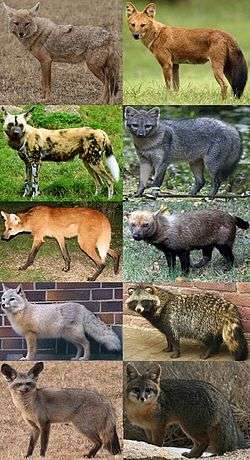Caninae
| Canines Temporal range: Early Miocene - Recent | |
|---|---|
 | |
| Diversity of Canines | |
| Scientific classification | |
| Kingdom: | Animalia |
| Phylum: | Chordata |
| Class: | Mammalia |
| Order: | Carnivora |
| Family: | Canidae |
| Subfamily: | Caninae G. Fischer de Waldheim, 1817 |
| Genera[1][2][3][4] | |
In the history of the carnivores, the family Canidae is represented by the two extinct subfamilies designated as Hesperocyoninae and Borophaginae, and the extant subfamily Caninae.[5] This subfamily includes all living canids and their most recent fossil relatives.[6] Their fossils have been found in Lower Oligocene North America, and they did not spread to Asia until the end of the Miocene,[7][8][9][10] some 7 million to 8 million years ago.[5] Many extinct species of Caninae were endemic to North America, living from 34 million to 11,000 years ago.[11]
Taxonomy
"Derived characteristics that distinguish the Caninae from other canids include small, simple, well-spaced premolars, a humerus without an entepicondylar foramen, and a metatarsal 1 which is reduced to a proximal rudiment."[12]
Based on genetic assumptions, the present-day, more-basal canids include:[13]
References
- ↑ McKenna, M. C; S. K. Bell (1997). Classification of Mammals Above the Species Level. Columbia University Press. ISBN 0-231-11012-X.
- ↑ Lyras G.A., Van der Geer A.E., Dermitzakis M., De Vos J. (2006) Cynotherium sardous, an insular canid (Mammalia: Carnivora) from the Pleistocene of Sardinia (Italy), and its origin. Journal of Vertebrate Paleontology: Vol. 26, No. 3 pp. 735–745
- ↑ Wozencraft, W.C. (2005). "Order Carnivora". In Wilson, D.E.; Reeder, D.M. Mammal Species of the World: A Taxonomic and Geographic Reference (3rd ed.). Johns Hopkins University Press. pp. 532–628. ISBN 978-0-8018-8221-0. OCLC 62265494.
- ↑ Sotnikova, M. (2006). "A new canid Nurocyon chonokhariensis gen. et sp. nov.(Canini, Canidae, Mammalia) from the Pliocene of Mongolia" (PDF). Courier Forschungsinstitut Senckenberg. 256: 11. Retrieved 2008-05-04.
- 1 2 Miklosi, Adam (2015). Dog Behaviour, Evolution, and Cognition. Oxford Biology (2 ed.). Oxford University Press. pp. 103–107. ISBN 978-0199545667.
- ↑ Tedford, Richard; Xiaoming Wang; Beryl E. Taylor (2009). "Phylogenetic systematics of the North American fossil Caninae (Carnivora: Canidae)". Bulletin of the American Museum of Natural History. 325: 1–218. doi:10.1206/574.1.
- ↑ Rook L (1993) I cani dell’Eurasia dal Miocene superiore al Pleistocene medio. PhD Dissertation, Modena-Bologna-Firenze-Roma “La Sapienza” Universities
- ↑ Rook L (2009) The wide ranging genus Eucyon Tedford & Qiu, 1996 (Mammalia, Carnivora, Canidae) in Mio-Pliocene of the Old World. Geodiversitas 31: 723–743
- ↑ Wang, Xiaoming; Tedford, Richard H.; Dogs: Their Fossil Relatives and Evolutionary History. New York: Columbia University Press, 2008.
- ↑ Re-Defining Canis etruscus (Canidae, Mammalia): A New Look into the Evolutionary History of Early Pleistocene Dogs Resulting from the Outstanding Fossil Record from Pantalla (Italy) Cherin, Marco ; Bertè, Davide ; Rook, Lorenzo ; Sardella, Raffaele, Journal of Mammalian Evolution, 2014, Vol.21(1), pp.95-110
- ↑ Paleobiology Database: Caninae Basic info.
- ↑ In Evolution of Tertiary mammals of North America, ed. C. M. Janis, K. M. Scott, and L. L. Jacobs. New York: Cambridge University Press 1998. Chapter 7, Canidae by Kathleen Munthe, p124-143
- ↑ Macdonald, David W.; Sillero-Zubir, Claudio, The Biology and Conservation of Wild Canids, Oxford University Press, retrieved February 16, 2016
Further reading
- Xiaoming Wang, Richard H. Tedford, Mauricio Antón, Dogs: Their Fossil Relatives and Evolutionary History, New York : Columbia University Press, 2008; ISBN 978-0-231-13528-3